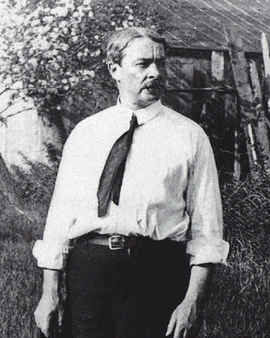Childe Hassam was an American artist who became known above all for his impressionist drawings. Hassam was born in 1859 near Boston in the United States. His family belongs to the wealthy elite of Boston. His father was an ironmonger and collected expensive antiques as a hobby. Even as a young boy, Hassam was surrounded by aesthetic and tasteful things, which gave him an insight into the world of fine arts. However, a major fire destroyed his father's factory in 1872. Hassam, who was still attending school at that time, had to leave school to support the family financially. He quickly found employment with a publishing house, but had no interest in the publishing business. Because of this, he started an apprenticeship as a graphic artist a little later. In addition, the ambitious young man attended several evening classes at the Boston Art Club and studied - even if only briefly - with William Rimmer at Lowell Institute. Hassam also took private painting lessons.
As a 24-year-old, Hassam travelled the European continent for two months. He was particularly fond of Great Britain. At the end of this inspiring journey he moved to France, where he enrolled as a student at the Académie Julian art school in Paris. The Académie Julian School of Art had a conservative orientation. Hassam, however, was attracted to progressive impressionism, so he always included light elements of the avant-garde style in his works.
In 1889 he returned to his home country, this time to the pulsating metropolis of New York. Here he learned to integrate his understanding of Impressionism without compromise into his own style of clear compositional structures and forms. City views of New York became Hassam's favorite motifs. He also created numerous illustrations for renowned magazines like Harper's and The Century. His flair for bright, impressive colors and quick brushstrokes made him one of the leading impressionists in the USA. Hassam visited Europe again twice: among other places, he made stops in Pont-Aven, painted by many Post-Impressionists, and in the south of Spain. Hassam was a member of the Society of American Artists. After leaving, he founded the Ten American Painters together with other American artist colleagues such as J. Alden Weir and John Henry Twachtman.
Influenced by the works of his friend Weir, Hassam experimented with etchings and lithographs. As an established artist he settled in 1920 in a summer studio in East Hampton on Long Island. For the remaining fifteen years of his life he remained productive and exhibited regularly. Hassam enjoyed great national recognition and was awarded several prizes and honors.
×





.jpg)
.jpg)
.jpg)
.jpg)
.jpg)
.jpg)
.jpg)
.jpg)
.jpg)
.jpg)
.jpg)
.jpg)
.jpg)
.jpg)
.jpg)
.jpg)
.jpg)
.jpg)
.jpg)
.jpg)
.jpg)
.jpg)
.jpg)
.jpg)
.jpg)
.jpg)
 - (MeisterDrucke-6017).jpg)
 - (MeisterDrucke-6017).jpg)
.jpg)
.jpg)
_-_(MeisterDrucke-1601274).jpg)
_-_(MeisterDrucke-1601274).jpg)
.jpg)
.jpg)
.jpg)
.jpg)
.jpg)
.jpg)
.jpg)
.jpg)
.jpg)
.jpg)
.jpg)
.jpg)
.jpg)
.jpg)
.jpg)
.jpg)
.jpg)
.jpg)
.jpg)
.jpg)
.jpg)
.jpg)
.jpg)
.jpg)
.jpg)
.jpg)
.jpg)
.jpg)
.jpg)
.jpg)
.jpg)
.jpg)
.jpg)
.jpg)
.jpg)
.jpg)
.jpg)
.jpg)
.jpg)
.jpg)
.jpg)
.jpg)
.jpg)
.jpg)
.jpg)
.jpg)
_-_(MeisterDrucke-1222371).jpg)
_-_(MeisterDrucke-1222371).jpg)
.jpg)
.jpg)
.jpg)
.jpg)
.jpg)
.jpg)
.jpg)
.jpg)
.jpg)
.jpg)
.jpg)
.jpg)
.jpg)
.jpg)
.jpg)
.jpg)
.jpg)
.jpg)
.jpg)
.jpg)
.jpg)
.jpg)
.jpg)
.jpg)
.jpg)
.jpg)
.jpg)
.jpg)
.jpg)
.jpg)
.jpg)
.jpg)
.jpg)
.jpg)
.jpg)
.jpg)
.jpg)
.jpg)
.jpg)
.jpg)
.jpg)
.jpg)
.jpg)
.jpg)
.jpg)
.jpg)
.jpg)
.jpg)
.jpg)
.jpg)
.jpg)
.jpg)
.jpg)
.jpg)
.jpg)
.jpg)
_-_(MeisterDrucke-1601584).jpg)
_-_(MeisterDrucke-1601584).jpg)
.jpg)
.jpg)
.jpg)
.jpg)
.jpg)
.jpg)
.jpg)
.jpg)
.jpg)
.jpg)
.jpg)
.jpg)
.jpg)
.jpg)
.jpg)
.jpg)
.jpg)
.jpg)
.jpg)
.jpg)
.jpg)
.jpg)
.jpg)
.jpg)
.jpg)
.jpg)
.jpg)
.jpg)
_Rainy_day_in_Boston_1885_Oil_on_canvas_-_(MeisterDrucke-857479).jpg)
_Rainy_day_in_Boston_1885_Oil_on_canvas_-_(MeisterDrucke-857479).jpg)
.jpg)
.jpg)
.jpg)
.jpg)
.jpg)
.jpg)
.jpg)
.jpg)
.jpg)
.jpg)
.jpg)
.jpg)
.jpg)
.jpg)
.jpg)
.jpg)
.jpg)
.jpg)
.jpg)
.jpg)
_-_(MeisterDrucke-1602976).jpg)
_-_(MeisterDrucke-1602976).jpg)
_-_(MeisterDrucke-1604858).jpg)
_-_(MeisterDrucke-1604858).jpg)
.jpg)
.jpg)
.jpg)
.jpg)
.jpg)
.jpg)






